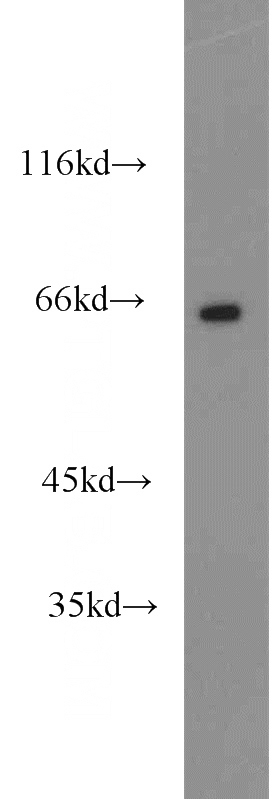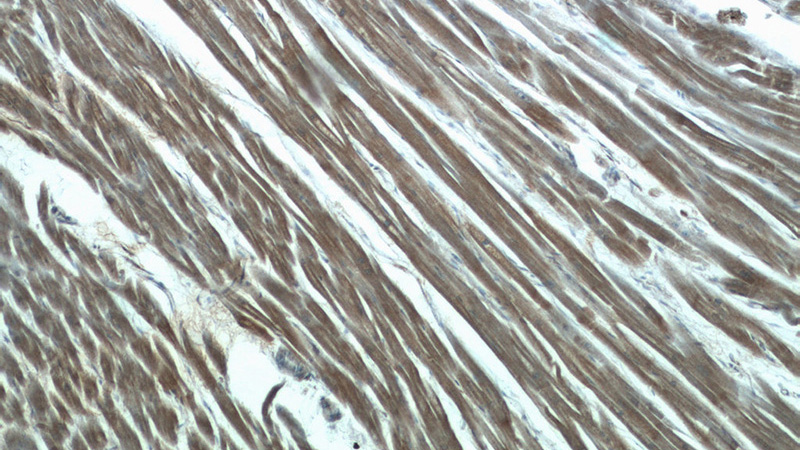-
Product Name
LMOD3 antibody
- Documents
-
Description
LMOD3 Rabbit Polyclonal antibody. Positive IHC detected in human heart tissue, human skeletal muscle tissue. Positive IP detected in mouse skeletal muscle tissue. Positive WB detected in human heart tissue, mouse heart tissue, rat skeletal muscle tissue. Observed molecular weight by Western-blot: 65-70 kDa
-
Tested applications
ELISA, WB, IHC, IP
-
Species reactivity
Human, Mouse, Rat; other species not tested.
-
Alternative names
DKFZp313F0135 antibody; Leiomodin 3 antibody; leiomodin 3 (fetal) antibody; Leiomodin antibody; fetal form antibody; LMOD3 antibody
-
Isotype
Rabbit IgG
-
Preparation
This antibody was obtained by immunization of LMOD3 recombinant protein (Accession Number: BC039202). Purification method: Antigen affinity purified.
-
Clonality
Polyclonal
-
Formulation
PBS with 0.02% sodium azide and 50% glycerol pH 7.3.
-
Storage instructions
Store at -20℃. DO NOT ALIQUOT
-
Applications
Recommended Dilution:
WB: 1:500-1:5000
IP: 1:200-1:2000
IHC: 1:20-1:200
-
Validations

human heart tissue were subjected to SDS PAGE followed by western blot with Catalog No:112285(LMOD3 antibody) at dilution of 1:1500

IP Result of anti-LMOD3 (IP:Catalog No:112285, 4ug; Detection:Catalog No:112285 1:700) with mouse skeletal muscle tissue lysate 3600ug.

Immunohistochemistry of paraffin-embedded human heart tissue slide using Catalog No:112285(LMOD3 Antibody) at dilution of 1:50 (under 10x lens)

Immunohistochemistry of paraffin-embedded human heart tissue slide using Catalog No:112285(LMOD3 Antibody) at dilution of 1:50 (under 40x lens)
-
Background
The gene encoding LMOD3 has not been characterized so far and very limited information of its function has been reported. Nanda et al. found that the expression of mouse LMOD3 mRNA is restricted largely to cardiac and skeletal muscle through RT-PCR analysis ( 22157009). Two isoforms of LMOD3 may exist due to the alternative splicing, whose molecular weights are predicted as 65 kDa and 40 kDa, respectively (Uniprot). This antibody was raised against the N-terminal region of human LMOD3. It detects a double bands around 80 kDa and 65 kDa in heart and skeletal muscle lysates. The reason causing the discrepancy between the predicted and observed molecular weight is not clear.
-
References
- Cenik BK, Garg A, McAnally JR. Severe myopathy in mice lacking the MEF2/SRF-dependent gene leiomodin-3. The Journal of clinical investigation. 125(4):1569-78. 2015.
- Yuen M, Sandaradura SA, Dowling JJ. Leiomodin-3 dysfunction results in thin filament disorganization and nemaline myopathy. The Journal of clinical investigation. 124(11):4693-708. 2014.
- Scheffer DI, Shen J, Corey DP, Chen ZY. Gene Expression by Mouse Inner Ear Hair Cells during Development. The Journal of neuroscience : the official journal of the Society for Neuroscience. 35(16):6366-80. 2015.
- Pappas CT, Mayfield RM, Henderson C. Knockout of Lmod2 results in shorter thin filaments followed by dilated cardiomyopathy and juvenile lethality. Proceedings of the National Academy of Sciences of the United States of America. 112(44):13573-8. 2015.
- Gokhin DS, Ochala J, Domenighetti AA, Fowler VM. Tropomodulin 1 directly controls thin filament length in both wild-type and tropomodulin 4-deficient skeletal muscle. Development (Cambridge, England). 142(24):4351-62. 2015.
- Nworu CU, Krieg PA, Gregorio CC. Preparation of developing Xenopus muscle for sarcomeric protein localization by high-resolution imaging. Methods (San Diego, Calif.). 66(3):370-9. 2014.
- Garg A, O'Rourke J, Long C. KLHL40 deficiency destabilizes thin filament proteins and promotes nemaline myopathy. The Journal of clinical investigation. 124(8):3529-39. 2014.
- Nworu CU, Kraft R, Schnurr DC, Gregorio CC, Krieg PA. Leiomodin 3 and tropomodulin 4 have overlapping functions during skeletal myofibrillogenesis. Journal of cell science. 128(2):239-50. 2015.
Related Products / Services
Please note: All products are "FOR RESEARCH USE ONLY AND ARE NOT INTENDED FOR DIAGNOSTIC OR THERAPEUTIC USE"
